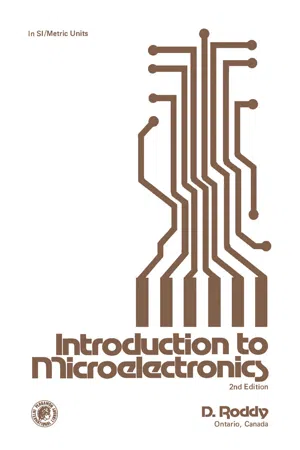Physics
Band Theory
Band theory is a concept in solid-state physics that explains the behavior of electrons in a crystalline solid. It describes the energy levels of electrons within a solid, forming bands of allowed energy levels. These bands are separated by energy gaps, and the behavior of electrons within these bands determines the electrical and thermal properties of the material.
Written by Perlego with AI-assistance
Related key terms
1 of 5
10 Key excerpts on "Band Theory"
- eBook - PDF
- P.T. Landsberg(Author)
- 2016(Publication Date)
- North Holland(Publisher)
CHAPTER 1 Contemporary Topics in Band Theory MARK RASOLT Solid State Division Oak Ridge National Laboratory Oak Ridge, TN 37831-6032, USA Handbook on Semiconductors Completely Revised Edition Edited by TS. Moss © Elsevier Science Publishers B.V, 1992 Volume 1, edited by P.Τ Landsberg 1 Contents 1. Introduction 3 2. The two types of band structures 5 2.1. Empirical pseudopotential method 5 2.2. Ab initio pseudopotential method 12 2.3. The self-energy formulation of Band Theory 15 3. Band gap discontinuities 22 3.1. Weak external potential 23 3.1.1. N o interaction between the particles 23 3.1.2. Interacting systems 24 3.2. Expansion of E_n in powers of the nonuniform density deviation 25 3.3. General derivation of the band gap discontinuities 30 4. Continuous internal symmetries in the band structure of donor-doped multivalley semiconductors 33 4.1. Continuous symmetries within the effective-mass Hamiltonian 34 4.2. The energy of H in the RPA 35 4.3. Effective Hamiltonian for the valley electrons 36 4.3.1. Frequency-dependent corrections 39 4.3.2. Higher-order corrections from G c 40 4.4. The effective-mass Hamiltonian 41 References 43 2 1. Introduction When we dynamically probe metals, semimetals, semiconductors, insulators (or for that matter any collection of electrons and ions) we are measuring the response of an excited many-body system to an external field. When we measure their static properties we are studying the thermodynamic properties of a many-body system. In both cases, when the nuclei are placed periodically (we will here exclusively consider only periodic systems and furthermore only systems where the electron density is commensurate with this periodicity) some form of Band Theory is generally the initial starting point. It is then very important to understand what such a Band Theory represents. - Dennis L. Eggleston(Author)
- 2011(Publication Date)
- Cambridge University Press(Publisher)
3.1.2 Band Theory Imagine we are constructing a material consisting of N atoms as described above, but we have not added any electrons yet. We now start to add electrons to the solid, starting with the lowest energy level. As with atomic energy levels, only certain 3.1 The Band Theory of solids 69 E a Figure 3.1 Schematic representation of energy level splitting as a solid is assembled. Here a is the distance between atoms. The light gray shading represents the large number of closely spaced energy levels produced by the splitting of the original atomic energy level. The dotted line represents the equilibrium spacing. At this spacing the solid is characterized by energy bands. E x Allowed and filled Forbidden Allowed and partially filled Figure 3.2 Energy band structure for a conductor. energies are allowed and we can only place two electrons in each level due to the Pauli Exclusion Principle. We continue to fill energy levels from the bottom up until we have used all the electrons normally associated with our N atoms. The character of the resulting band structure determines whether a material is a conductor, an insulator, or a semiconductor. Consider, for example, the case shown in Fig. 3.2 , where we plot energy level versus position x within the material. We show only the upper energy levels since these are the ones of interest; the lower energy levels are all filled with electrons and do not change under normal material operations. Moving from the bottom of the figure up, we show a band of allowed energy levels that are filled with electrons, followed by a band of non-allowed (or forbidden) energies, followed by an allowed band that is only partially filled with electrons. It is the fact that this last band is only partially filled that makes this material a conductor . In order to produce a current, electrons in a material must move and thus must increase their energy slightly. They must, therefore, be able to move to a slightly higher energy level.- eBook - PDF
- Md Nazoor Khan, Simanchala Panigrahi(Authors)
- 2017(Publication Date)
- Cambridge University Press(Publisher)
11 Energy Bands in Solids 11.1 Introduction The behaviour of electrons and their energies in solids is related to the behaviour of all other particles around them where as their behavior in free space is completely different. The electrons in free space can posses any specified energy. The certain ranges of energies possessed by the electrons in a solid are called allowed energy bands and certain ranges of energies that can not be possessed by the electrons are called forbidden energy bands. The Band Theory accounts for many of the electrical and thermal properties of solids and gives the basic concepts behind the technological advancements of materials. The energy Band Theory of solids plays the most vital role in the development of semicondutor devices. The energy changes of electrons in solids interacting with photons of light, energetic electrons, x-rays and the like confirm the general validity of the Band Theory and provide detailed information about allowed and forbidden energy bands. 11.2 Origin of Energy Bands The concepts of energy bands in solids can be accounted for by two different approaches; one is the classical approach and the other is the quantum mechanical approach. 11.2.1 Origin of energy bands: The classical approach In the classical approach, the band of energies permitted in a solid is related to the discrete allowed energies – the energy levels of single, isolated atoms. According to the Bohr’s atomic model, the energy level diagram of a hydrogen atom is depicted in Fig. 11.1, for three principal quantum numbers. As illustrated in the Fig. 11.1, an electron cannot have any energy between –13.6 eV and –3.4 eV. These are the energy levels of Bohr’s hydrogen atom for principal quantum numbers 1 and 2 respectively. Energy Bands in Solids 407 Figure 11.1 (a) The first three energy states of the hydrogen atom according to Bohr’s model. - eBook - PDF
- Prasanta Kumar Basu, Bratati Mukhopadhyay, Rikmantra Basu(Authors)
- 2015(Publication Date)
- CRC Press(Publisher)
109 4 Band Structures 4.1 Introduction The formation of bands in a periodic crystalline solid was discussed quali-tatively in Chapter 2. It was also mentioned that the calculation of the band structure in semiconductors involves the solution of the one-electron Schrödinger equation in the presence of a periodic potential. Most text-books on solid-state physics and semiconductors discuss the Kronig–Penney model, the nearly free-electron model, or the tight binding model to illus-trate the formation of bands in crystals. The band structure is described by the E – k diagram, and a brief introduction to the diagram has been given in Chapter 2. The quantitative understanding of the electronic and optical processes and analysis of experimental data depend on the accurate E – k relationship of the semiconductor under study. Though powerful techniques, such as the pseu-dopotential method, exist to predict the band structure, there are approxi-mate methods that can satisfactorily explain most of the important electronic and optoelectronic behavior of semiconductors. The most widely used method, the k . p perturbation method, will be described in this chapter in relation to the band structure in bulk semiconductors first. The modification for quantum wells (QWs) and strained layers will be described thereafter. 4.2 Band Theory: Bloch Functions A solid consists of many atoms and electrons. The total energy of the system is therefore the sum of the kinetic energies of all the nuclei and electrons and all the potential energies, which arise due to nuclear forces, interaction of electrons in the field of nuclei due to electron–electron interactions, and the magnetic energy associated with the spin and the orbit. The total Hamiltonian of the system may be constructed accordingly. It follows naturally, therefore, that the solution of the resultant Schrödinger equation is a formidable task. 110 Semiconductor Laser Theory The problem is bypassed by introducing several approximations. - eBook - PDF
- Dermot Roddy(Author)
- 2013(Publication Date)
- Pergamon(Publisher)
CHAPTER 1 Basic Theory 1.1. Introduction Electrons in solids possess energy, the kinetic energy component arising through various motional states, and the potential energy mainly from the electrostatic field of the atomic nucleii. The total energy is quantized, that is, it can only be altered in discrete amounts (for example by application of an external voltage, or by incident radiation). In a solid, these discrete energy levels are grouped into bands as a result of interaction between the atomic nucleii, and the density of levels within a given band is sufficiently high for the energy range to be considered continuous (i.e. its discrete nature may be ignored within a band). The bands themselves may be separated by comparatively large energy gaps, in which no permissible energy levels occur, these being referred to as forbidden energy gaps. Operation of solid state electronic devices and circuits results from the fact that energy levels within a solid can be shifted in a controlled manner, this giving rise to some remarkable properties not explainable on a simple electronic charge picture of electronic conduction. 1.2. Energy Bands in Solids For electrical conduction to occur in a solid it must be possible for electrons within it to change their energetic states, since an externally applied voltage is going to impart energy to the electrons. This means that not only must there be electrons available for conduction, but empty energy levels must be available for these. Figure 1.1 shows a one-dimensional energy band diagram, which is simply an energy scale showing permissible and forbidden bands. The lower energy bands l 2 Introduction to Microelectronics apply to electrons close to the nucleii, and as these bands are normally completely filled (the closed shells in chemical binding), they cannot contribute to electrical conduction. Only the two outermost bands, the valence band and the conduction band, are of importance in the operation of electronic devices. - eBook - PDF
- J Phillips(Author)
- 2012(Publication Date)
- Academic Press(Publisher)
Energy Bands THE LANGUAGE OF Band Theory The energy bands of solids, and particularly crystals with a large number of valence electrons per unit cell, appear quite complicated at first sight. This is especially true of semiconductors, for even the simplest ones have eight valence electrons per unit cell, compared for example to alkali metals, with only one conduction electron per unit cell. Fortunately much of this complexity disappears after one has learned what to expect. First, however, let us remind ourselves of the language of Band Theory. The one feature of the quantum states of crystals which every student is expected to know is that the electronic wave functions have a special form imposed by the translational periodicity of the crystal. Each electronic wave function is assigned a crystal momentum p = hk, where k is a wave vector, and a band index n. The wave function ψ η ^ has the Bloch form ^nk(*) = [exp(ikT)]wn k (r), (61.) where ii W k(r) is a periodic function of r with the periodicity of the crystal lattice [1]. The energy of the state ^nk(r) is represented by E n (k). 98 The Language of Band Theory 99 Just as with lattice vibrations, the wave vector k ranges over reciprocal space, which is made up of Brillouin zones as discussed in Chapter 4. The first two Brillouin zones of a square lattice are shown in Fig. 5.1. The reciprocal lattice which is conjugate to a square lattice is itself square. The unit cell of a square lattice is square, so that this is the first Brillouin zone. The second Brillouin zone consists of the four shaded triangles shown in the figure. The area of the second Brillouin zone is equal to the area of the first zone, as one can see by folding back the four triangles into the first zone. The process of folding back becomes much more complicated for higher zones, and for other lattices, especially in three dimensions [2]. - eBook - PDF
Understanding Solid State Physics
Problems and Solutions
- Jacques Cazaux(Author)
- 2016(Publication Date)
- Jenny Stanford Publishing(Publisher)
Course Summary 1. Introduction The free electron model can be successfully applied to certain metals. However, it does not account for the electrical properties of semimetals, semiconductors, and insulators because it neglects the potential energy of valence electrons in the periodic potential of the ions of crystal lattice. 2. Band Theory The general solutions of the Schrödinger equation 2 2 2 m V E — + È Î Í Í ˘ ˚ ˙ ˙ = y y , where V takes into account the periodic nature of the lattice, are Bloch waves of form y ( ) ( ) . r u r e ik r = in which u(ŕ) like V takes into account the periodicity of the lattice. In 1D, u ( x ) = u ( x + a ) because V ( x ) = V ( x + a ). The wave vector k , therefore, always refers to a spatial orientation, and the components of k are, as for free electrons, quantized (cyclic boundary conditions k x = n x 2 π / L x , k y = n y 2 iπ / L y , k z = n z 2 π / L z ) and the integers n x , n y , and n z are good quantum numbers of electrons. Chapter V Band Theory: Other Metals, Semiconductors, and Insulators Understanding Solid State Physics: Problems and Solutions Jacques Cazaux Copyright © 2016 Pan Stanford Publishing Pte. Ltd. ISBN 978-981-4267-89-2 (Hardcover), 978-981-4267-90-8 (eBook) www.panstanford.com 458 Band Theory Beyond the general form indicated above, rigorous analytical solutions are impossible to obtain. Depending on the nature of the crystal, various simplifications can be introduced to obtain the dispersion relation E = f ( k ). For metals, simplifications result in the nearly free-electron approximation. For a periodic crystalline potential, the perturbation on the propagation of the valence electrons is a small correction. The resulting dispersion relation deviates from the parabolic free electron relation only when the wave vector k approaches the limits of the Brillouin zones where the Bragg conditions are nearly satisfied. - eBook - PDF
- Stephen Thornton, Andrew Rex, Carol Hood, , Stephen Thornton, Stephen Thornton, Andrew Rex, Carol Hood(Authors)
- 2020(Publication Date)
- Cengage Learning EMEA(Publisher)
You will see how it is possible to understand the behavior of semiconductors by using the quantum theory of solids. We in- tend to present just enough of the theory in descriptive fashion to allow you to appreciate the versatility and importance of semiconductor materials. 11.1 Band Theory of Solids In Chapter 10 you learned about structural, thermal, and magnetic properties of solids. Here we concentrate on electrical conduction. There are three categories of solids, based on their conducting properties: conductors, semiconductors, and insulators. As seen in Table 11.1, the electrical conductivity at room temperature is quite different for each of these three kinds of solids. Semiconductor Theory and Devices 11 Copyright 2021 Cengage Learning. All Rights Reserved. May not be copied, scanned, or duplicated, in whole or in part. Due to electronic rights, some third party content may be suppressed from the eBook and/or eChapter(s). Editorial review has deemed that any suppressed content does not materially affect the overall learning experience. Cengage Learning reserves the right to remove additional content at any time if subsequent rights restrictions require it. 398 Chapter 11 Semiconductor Theory and Devices Metals and alloys have the highest conductivities, followed by semiconductors, and then insulators. We have already modeled the electrical conductivity of or- dinary metals in Section 9.6. The free-electron model used in Chapter 9 does not apply to semiconduc- tors and insulators. In fact there is a different conduction mechanism for semi- conductors than for metals. Striking evidence of this fact is seen in the resistivity- versus-temperature graphs presented in Figure 11.1. Although the free-electron theory correctly predicts a linear increase in resistivity with temperature, semi- conductors generally exhibit decreasing resistivity with increasing temperature. - Marc J. Madou(Author)
- 2011(Publication Date)
- CRC Press(Publisher)
75 O u t l i n e Introduction Classical Theory Starts Faltering Quantum Mechanics to the Rescue Beyond Schrödinger’s Equation 3 QuantumMechanics andtheBand TheoryofSolids (a) (b) (c) (d) (e) (f) (g) (h) Some of the actors in this chapter: (a) Fermi, (b) Schrödinger, (c) de Broglie, (d) Feynman, (e) Born, (f) Bohr, (g) Rutherford, (h) Dirac; and below is Einstein. Theonlyreasonfortimeissothateverythingdoesn’thappenatonce. Albert Einstein Nothingisreal. John Lennon, 1940–1980 76 Solid-State Physics, Fluidics, and Analytical Techniques in Micro- and Nanotechnology Introduction As we came to understand from Chapter 2 , when atomsarebroughttogetherincrystals,theirouter-mostelectronsareinfluencedbyaperiodicpoten-tial. Therefore, the possible electron energies form bandsofallowedvaluesseparatedbybandsoffor-biddenvalues.Thisbandstructureisoffundamental importanceinexplainingthepropertiesofmetals, semiconductors,andinsulators.Themostaccepted andmostaccuratetheoryinmodernphysicstoday, topredictphysical,mechanical,chemical,andelec-tricalpropertiesofatoms,molecules,andsolids— including the Band Theory of solids—is quantum mechanics. At the end of the nineteenth century, physicists thoughttheyhadagoodgraspofthephysicalworld with mechanics (e.g., Newton, Hamilton, and Lagrange),statisticalmechanics(mostlyBoltzmann and Gibbs), hydrodynamics (Stokes), and electro-dynamics (Maxwell). There had been a growing unease, though, about the incapability of classical theories to explain a wide variety of experiments, such as the magnitude of the electrical and ther-malconductivityofmetalsandtheheatcapacityof metalsandinsulators.Confidencewasfurtherchal-lengedbyaseriesofnewdiscoveries:radioactivity (1896), the electron (1897), the quantum (1900), the photoelectric effect (1887), and x-rays (1895).- eBook - PDF
- Jun Kondo, Shigeru Koikegami, Kosuke Odagiri, Kunihiko Yamaji, Takashi Yanagisawa(Authors)
- 2012(Publication Date)
- Cambridge University Press(Publisher)
4 Band Theory The subject of this chapter is solving the Schrödinger equation for electrons moving in a periodic mean field in crystals. The solution is called the Bloch orbital. We discuss Bloch’s theorem, which applies to it. As for the energy eigenvalues, there are allowed and forbidden values. The allowed values are distributed in extended regions that are called bands. The forbidden values comprise the gaps. In order to calculate the Bloch orbital, we make use of an approximation based on the free electron model, and another approximation based on the linear combination of atomic orbitals. As a more realistic approach, we discuss the Wigner–Seitz method. 4.1 The periodic structure of crystals In the previous chapter, we showed that many experimental facts can be explained by assuming that the conduction electrons in metals move in a uniform mean field. However, in real metals, there are collisions with ions. A question arises as to why these collisions do not cause a significant effect. Moreover, there are some problems that cannot be explained in the free electron model. One such problem is the quantitative deviations from the experimental results. Also, the signs associated with the Hall effect and the thermoelectric power are often opposite to that expected in the free electron model. Another problem is why this model does not apply at all to the case of insulators. In order to answer these questions, we have to move on to more realistic models than the free electron model. As we do so, an important point to bear in mind is that the atoms are placed with a regular order in crystals, so that the electrons are subject to a mean field that has the same type of regularity. As a preparation to solving the Schrödinger equation for such an electron, we discuss the geometry governing the periodicity of the arrangement of atoms. 49 50 Band Theory Let us adopt a 1 , a 2 , a 3 as the three fundamental vectors.
Index pages curate the most relevant extracts from our library of academic textbooks. They’ve been created using an in-house natural language model (NLM), each adding context and meaning to key research topics.









